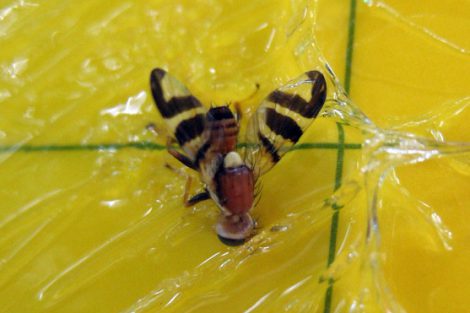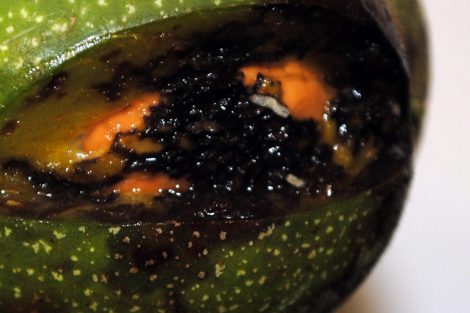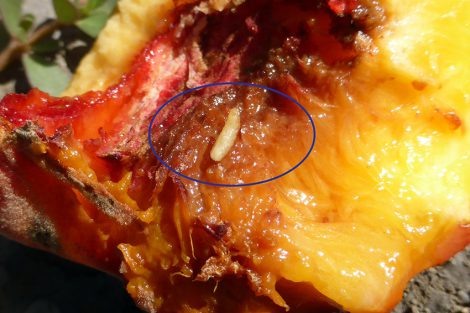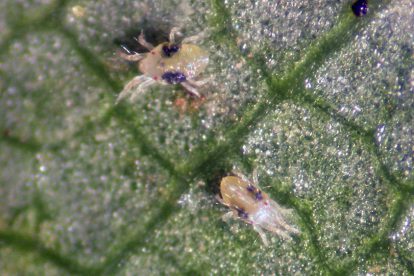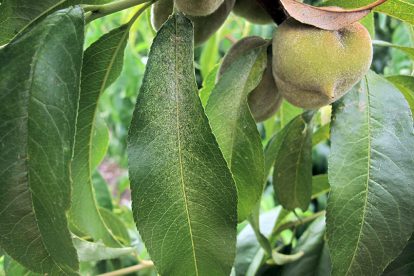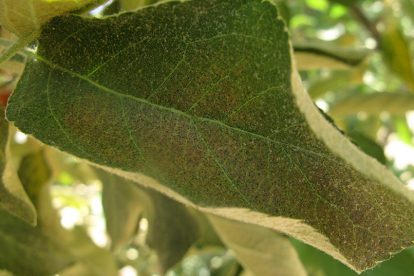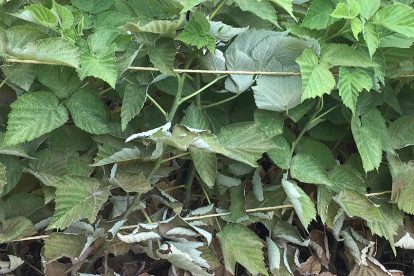In this Issue
- Codling moth and Peach twig borer: Updated dates for start of second generation egg hatch
- Apple: White apple leafhopper adults are active
- Apricot, peach/nectarine: Walnut husk fly will be laying eggs soon; time to start protecting trunks from greater peachtree borer
- All tree and small fruits: Watch foliage for spider mite feeding injury
- Berries: Prune off wilted cane tops and watch for dying canes infested with rose stem girdler
APPLE, PEAR
Codling Moth
Most areas do not need treatment until second generation
View a pdf of the updated spray timing table. Be sure to read the instructions at the top of the page, for how to read the table.
Egg hatch of the first generation is ending soon for most sites. Check the start date of the second generation egg hatch, and wait to apply your next spray at that time. And then from that point forward, keep the fruit protected up until September 15.
Treatment
- Residential options: See the post from May 12, 2023 (scroll down to the table after the page opens)
- Commercial growers
White Apple Leafhopper
Adults are active now; their offspring (nymphs) will be active in approx. 3 weeks
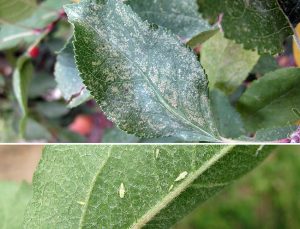
Leafhopper adults are active now, appearing as “white flies” that fly around when foliage is disturbed. Leafhoppers are a minor pest of apples (and cherry) and rarely cause economic damage. They feed on foliage with piercing-sucking mouthparts which causes stippling (tiny white spots), but this does not harm the tree or affect fruit size or yield.
Adults will soon begin to lay eggs, and the nymphs that hatch will also feed on foliage. But because nymphs are wingless, this pest is easier to manage by targeting this life stage. Most nymphs and adults are found on the undersides of the leaves.
Treatment
Treatment is usually warranted when the leafhoppers have been a nuisance at apple-picking time in previous years. Only treat the nymphs, not the adults.
- Residential: Insecticidal soap (many brands) or products containing pyrethrin are organic options, but must come into contact with the leafhoppers, which are on the undersides of the foliage. Good coverage is important and application should be repeated in 7 days. A few options for conventional treatment of codling moth also work on leafhoppers (Spectracide Triazicide, GardenTech Sevin, and related).
- Commercial: Options for leafhopper can be found by clicking here for apple, and here for cherry
PEACH/NECTARINE, APRICOT
Peach Twig Borer
First generation egg hatch will be ending soon in certain locations
View a pdf of the updated spray timing table. Be sure to read the instructions at the top of the page, for how to read the table.
In most areas, the first generation egg hatch will be ending in the next few weeks. The start of the second generation egg hatch is then a few weeks after that.
For the second generation, with high-population areas, two cover sprays may be required. In low population areas, only one application is needed.
Pay attention to apricots, which ripen earlier. At this time of year, peach twig borer larvae will be entering fruit as they ripen.
Treatment
- Residential options are the same as codling moth (see above)
- Commercial growers
Walnut Husk Fly
Adult flies will be laying eggs soon in northern Utah
According to the walnut husk fly model, protection of walnuts (plus apricots and peaches near walnut plantings) should begin at the time periods shown below. The peak egg-laying period will occur in early August, so an additional application will be needed then.
- Most areas of Wasatch Front: July 4 – 5
- Cooler areas (Benches, Cache, Carbon, etc.): July 14
Walnut husk fly is typically a pest of walnuts, but flies can also attack soft apricots or peaches growing near walnuts. Where you have had damage from husk fly in the past on these crops, the fruit will need to be kept protected with an insecticide starting at the above date, up until harvest.
On walnuts, when maggots feed on young, developing walnuts, the walnut shrivels, turns moldy, and drops prematurely. Later feeding (late Aug. – Sept.) will not affect the kernel, but will result in a husk that is stained black and a hull that is difficult to separate from the nut. If necessary, keep nuts protected up until one month before harvest. Eggs laid at that time will not be able to develop and cause damage.
Non-chemical Treatment (walnuts)
- Like cherry fruit fly, populations of walnut husk fly can be reduced by placing landscape fabric under the tree canopy in late summer to prevent larvae from entering the soil.
- Remove all walnuts that fall to the ground.
- Do not treat walnuts but instead, focus on making husk-removal easier. To do this, store infested nuts in a damp burlap bag for 2-3 days.
Treatment
- Residential: If you are making an application for peach twig borer, it will also target walnut husk fly on peach and apricot. Spinosad (many brands) is an excellent organic option. Spinosad can also be used on walnuts, up until one month before harvest.
- Commercial growers (peach)
Greater Peachtree Borer
Start protecting the trunks of peach/nectarine now
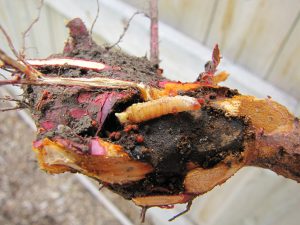
Protect the lower 12-18 inches of trunk for peach/nectarine, apricot, and plum. Start sprays now (if you have not already started) and keep protection on through September. Make sure the spray covers the entire surface area, particularly close to ground level, and any exposed roots.
Greater peachtree borer is a moth with a metallic, blue-black body that has narrow yellow bands and clear wings. Adult emergence and egg-laying will peak in mid-July to early August, and may extend into September, so that is the most important time to keep the bark protected. The female moth lays eggs in bark crevices and the creamy white larvae burrow into the bark and begin to feed on inner bark. There it will stay for the winter until the following spring, where it will begin feeding again until it pupates and
emerges as an adult.
Young trees can be killed when trunks are girdled by feeding; older trees are weakened and become susceptible to attack by pathogens and bark beetles.
Non-chemical Treatment Options
- Remove all weeds, grass, and excess soil from around the base of the tree. Heat and dryness reduce the survival of eggs and larvae.
- Avoid mechanical and rodent-caused injuries to trunks.
- Keep trees healthy with optimal nutrition and irrigation
Treatment
Materials for Residential growers include:
- Hi Yield permethrin products such as Garden & Farm Insect Control Spray, or Indoor/Outdoor Broad Use Insecticide (apply once/month)
- Spectracide Triazicide (apply every 3-4 weeks)
- Organic options are products containing spinosad or pyrethrin (apply every 7 to 10 days)
Options for commercial growers.
ALL FRUIT PLANTS
Spider Mites
Watch for foliage that appears bronzed or “dirty”
Spider mite activity is currently slow, but with the warmer weather to come, their populations will increase on raspberries, apples, peaches, and cherries. Check for mites by examining the lowest leaves on the canes and branches first. (Mites overwinter in groundcover and migrate up the plant in hot, dry weather.)
Look for leaves that are stippled (see image examples), and turn them over. Using a hand lens, look for the slow-moving mites. The mites also create webbing which traps dust and dirt, and this can be seen with the naked eye.
Before making a decision on whether to treat, use the magnifying lens to also look for predatory mites within the pest mite population. These are faster moving mites, about the same size, that can prevent spider mite densities from exceeding economic thresholds. If predators are present, then a treatment may not be necessary.
Treatment
- Do not let plants get drought-stressed and keep the dust down. For smaller farms, wash dust off foliage periodically.
- For residential application, a 0.5-1% application of horticultural oil is very effective on mites, especially when populations are low, and when the spray coverage is good enough to cover the undersides of the leaves. A 1% concentration is 2.5 tablespoons oil per gallon of water.
- Spider mite options for commercial growers. (Select crop, and then select “fruit present” stage.)
SMALL FRUITS
Raspberry Horntail
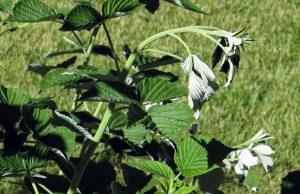
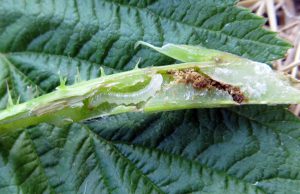
Prune out wilted tops of canes
Raspberry fruits are in various stages of maturity in northern Utah. Damage from the raspberry horntail has been visible for a few weeks now.
Now is the time to prune out the wilted portions of the canes and destroy the prunings. This will help to reduce the horntail population in your area. When pruning, be sure that you get the white larva inside the stem. It may be farther down the stem than you think. To get a feel for where the larvae are feeding, slice a few cut stems vertically to locate the larva.
Where there is no borer, the pith will be creamy-white. A pith with loose brown material will indicate borer activity.
Rose Stem Girdler
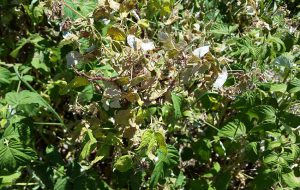
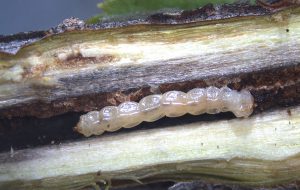
In previously infested areas, spray lower canes with insecticide
Another serious pest of raspberries is the rose stem girdler. The adult is a shiny, bronze-colored beetle. Adults are flying and laying eggs now. Females lay eggs near the base of the canes, and the larvae hatch and tunnel into the cane tissue.
Canes may have swellings at the feeding sites, and infested canes may break at weak areas later in the season. The best treatment option is to remove and destroy infested canes late in the season. For fall-bearing raspberries, be sure to cut all canes to the ground this fall to remove any borers inside the canes.
Treatment
- An organic spray is the ingredient, pyrethrin (Pyrellin EC*, Bonide Liquid Pyrethrin Spray)
- Treat cane stems every 7 days for the next 3 weeks, avoiding flowers

